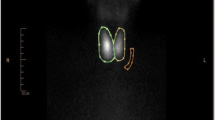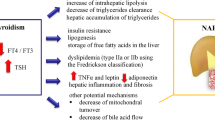Abstract
Variations in the serum concentration of interleukin-6 (IL-6) have been reported concomitantly with thyroid dysfunction: increased serum IL-6 levels have been found in patients with thyroidal destructive processes, such as subacute thyroiditis, some forms of amiodarone-induced thyrotoxicosis, or after percutaneous ethanol injection into “hot” thyroid nodules, as a result of the cytokine release from the damaged thyrocyte. In addition, recent in vitro evidence suggests that IL-6 might account, at least in part, for changes of thyroid economy found in nonthyroidal illness (NTI). In this cross-sectional study we addressed this problem by measuring serum IL-6 levels in 71 patients with NTI, due to neoplasia(n=25), chronic liver disease (n=9), chronic renal failure (n=28), or other chronic nonthyroidal disorders (n=9). These patients had reduced mean serum total T3 (TT3) and free T3 (FT3) concentrations, normal total and free T4 levels, normal TSH values, and increased serum reverse T3 (rT3) concentration (with the exception of chronic renal failure patients, who had normal rT3 levels). Serum IL-6 concentration was increased above normal (i.e. >100 fmol/L) in almost all NTI patients, especially in those with low T3 values (median value: 258 fmol/L, range 73–3210, vs 152 fmol/L, range <12.5–460, in patients with normal TT3 values, p<0.001). Serum IL-6 values in NTI patients were negatively correlated with serum FT3 values (r=0.56, p<0.001), and positively correlated with serum rT3 values (r=0.78, p<0.001). The increased serum IL-6 levels might represent a systemic reaction to disease, possibly mediated by stimulation of IL-6 synthesis and release induced by other cytokines, such as IL-1 and tumor necrosis factor. Whether IL-6 is simply a marker of NTI or is responsible, at least in part, for abnormalities of thyroid function tests, as suggested by previous in vitro evidence, remains to be established.
Similar content being viewed by others
References
Wong T.K., Hershman J.M. Changes in thyroid function in nonthyroid illness. Trends Endocrinol. Metab. 3: 8, 1992.
Wartofsky L., Burman K.D. Alterations in thyroid function in patients with systemic illness: the “euthyroid sick syndrome”. Endocr. Rev. 3: 164, 1982.
Bartalena L., Martino E., Brandi L.S., Falcone M., Pacchiarotti A., Ricci C., Bogazzi F., Grasso L., Mammoli C., Pinchera A. Lack of nocturnal serum thyrotropin surge after surgery. J. Clin. Endocrinol. Metab. 70: 293, 1990.
Bartalena L., Pacchiarotti A., Palla R., Antonangeli L., Mammoli C., Monzani F., De Negri F., Panichi V., Martino E., Baschieri L., Pinchera A. Lack of nocturnal serum thyrotropin (TSH) surge in patients with chronic renal failure undergoing regular maintenance hemofiltration: a case of central hypothyroidism. Clin. Nephrol. 34: 30, 1990.
Bartalena L., Placidi G.F., Martino E., Falcone M., Pellegrini L., Dell’Osso L., Pacchiarotti A., Pinchera A. Nocturnal serum thyrotropin (TSH) surge and the TSH response to TSH-releasing hormone: dissociated behavior in untreated depressives. J. Clin. Endocrinol. Metab. 71: 650, 1990.
Bartalena L., Cossu E., Grasso L., Velluzzi F., Loviselli A., Cirillo R., Martino E. Relationship between nocturnal serum thyrotropin peak and metabolic control in diabetic patients. J. Clin. Endocrinol. Metab. 76: 983, 1993.
Sato K., Satoh T., Shizume K., Ozawa M., Han D.C., Imamura H., Tsushima T., Demura H., Kanaji Y., Ito Y., Obara T., Fujimoto Y., Konaji Y. Inhibition of 125-1 organification and thyroid hormone release by interleukin-1, tumor necrosis factor-α and interferon-γ in human thyrocytes in suspension culture. J. Clin. Endocrinol. Metab. 70: 1735, 1990.
Pang X.P., Hershman J.M., Smith V., Pekary E.A., Sugawara M. The mechanism of action of tumor necrosis factor-alpha and interleukin-1. Acta Endocrinol. (Copenh.) 123: 203, 1990.
Poth M., Tseng Y-C.L., Wartofsky L. Inihibition of TSH activation of human cultured thyroid cells by tumor necrosis factor: an explanation for decreased thyroid function in systemic illness? Thyroid 1: 235, 1991.
Ozawa M., Sato K., Han D.C., Kawakami M., Tsushima T., Shizume K. Effects of tumor necrosis factor-alpha/cachectin on thyroid hormone metabolism in mice. Endocrinology 123: 1461, 1988.
Mooradian A.D., Reed D.L., Osterweil D., Schiffman R., Scuderi P. Decreased serum triiodothyronine is associated with increased concentration of tumor necrosis factor. J. Clin. Endocrinol. Metab. 71: 1239, 1990.
Van der Poll T., Romijn J.A., Wiersinga W.M., Sauerwein H.P. Tumor necrosis factor: a putative mediator of the sick euthyroid syndrome in man. J. Clin. Endocrinol. Metab. 71: 1567, 1990.
Chopra I.J., Sakane S., Chua Teco G.N. A study of the serum concentration of tumor necrosis factor-alpha in thyroidal and nonthyroidal illnesses. J. Clin. Endocrinol. Metab. 72: 1113, 1991.
Heinrich P.C., Castell J.V., Andus T. Interleukin-6 and the acute phase response. Biochem. J. 265: 621, 1990.
Bartalena L., Farsetti A., Flink I.L., Robbins J. Effects of interleukin-6 on the expression of thyroid hormone-binding protein genes in cultured human hepatoblastoma-derived (Hep G2) cells. Mol. Endocrinol. 6: 935, 1992.
Bartalena L., Hammond G.L., Farsetti A., Flink I.L., Robbins J. Interleukin-6 inhibits corticosteroid-binding globulin synthesis by human hepatoblastoma-derived (Hep G2) cells. Endocrinology 133: 291, 1993.
Tominaga T., Yamashita S., Nagayama Y., Morita S., Yokoyama N., Izumi M., Nagataki S. Interleukin 6 inhibits human thyroid peroxidase gene expression. Acta Endocrinol. (Copenh.) 124: 290, 1991.
Onoda N., Tsushima T., Isozaki O., Emoto N., Demura H., Arai M., Shizume K., Sato Y., Miyakawa M., Murakami H., Ohmura E. Effect of interleukin-6 on hypothalamic-pituitary-thyroid axis in rat. In: Nagataki S., Mori T., Torizuka K., (Eds.), 80 years of Hashimoto’s Disease. Elsevier Science Publ., Amsterdam, 1993, p. 355.
Bartalena L., Brogioni S., Grasso L., Martino E. Increased serum interleukin-6 concentration in patients with subacute thyroiditis: relationship with concomitant changes in serum T4-binding globulin concentration. J. Endocrinol. Invest. 16: 213, 1993.
Grubeck-Loebenstein B., Buchan G., Chantry D., Kassal H., Londei M., Pirich K., Barrett K., Turner M., Waldhausl W., Feldmann M. Analysis of intrathyroidal cytokine production in thyroid autoimmune disease: thyroid follicular cells produce interleukin-1α and interleukin-6. Clin. Exp. Immunol. 77: 324, 1989.
Weetman A.P., Bright-Thomas R., Freeman M. Regulation of interleukin-6 release by human thyrocytes. J. Endocrinol. 127: 351, 1990.
Iwamoto M., Sakihama T., Kimura N., Tasaka K., Onaya T. Augmented interleukin 6 production by rat thyrocytes (FRTL5): effect of interleukin-1ß and thyroid-stimulating hormone. Cytokine 3: 345, 1991.
Bartalena L., Grasso L., Brogioni S., Aghini-Lombardi F., Braverman L.E., Martino E. Serum interleukin-6 in amiodarone-induced thyrotoxicosis. J. Clin. Endocrinol. Metab. 78: 423, 1994.
Bartalena L., Pinchera A., Brogioni S., Grasso L., Rago T., Vitti P., Martino E. Serum interleukin-6 (IL-6) levels in thyroidal destructive processes. Thyroid 3 (Suppl.): T–37, 1993 (Abstract).
Houssiau F.A., Devogelaer J.-P., Van Damme J., Nagant de Deuxchaisnes C., Van Snick J. Interleukin-6 in synovial fluid and serum of patients with rheumatoid arthritis and other inflammatory arthritides. Arthritis Rheum. 31: 784, 1988.
Fearon K.C.H., McMillan D.C., Preston T., Winstanley P., Cruickshank A.M., Shenkin A. Elevated circulating interleukin-6 is associated with an acute-phase response but reduced fixed hepatic protein synthesis in patients with cancer. Ann. Surg. 213: 26, 1991.
Houssiau F.A., Bukasa K., Sindic C.J.M., Van Damme J., Van Snick J. Elevated levels of the 26 K human hybridoma growth factor (interleukin 6) in the cerebrospinal fluid of patients with acute infections of the central nervous system. Clin. Exp. Immunol. 71: 320, 1988.
Hack C.E., De Groot E.R., Felt-Bersma R.J.F., Nuijens J.H., Strack Van Schijndel R.J.M., Eerenberg-Belmer A.J.M., Thijs L.G., Arden L.A. Increased plasma levels of interleukin-6 in sepsis. Blood 74: 1704, 1989.
Reincke M., Allolio B., Petzke F., Heppner C., Mbulamberi D., Vollmer D., Winkelmann W., Chrousos G.P. Thyroid dysfunction in African trypanosomiasis: a possible role for inflammatory cytokines. Clin. Endocrinol. (Oxf.) 39: 455, 1993.
Casey L.C., Balk R.A., Bone R.C. Plasma cytokine and endotoxin levels correlate with survival in patients with the sepsis syndrome. Ann. Intern. Med. 119: 771, 1993.
Gershenwald J.E., Fong Y.M., Fahey T.J. III, Calvano S.E., Chizzonite R., Kilian P.L. Interleukin 1 receptor blockade attenuates the host inflammatory response. Proc. Natl. Acad. Sci. USA 87: 4966, 1990.
Fong Y., Tracey K.J., Moldawer L.L., Hesse D.G., Manogue K.B., Kenney J.S. Antibodies to cachectin/tumor necrosis factor reduce interleukin 1 and interleukin 6 appearance during lethal bacteremia. J. Exp. Med. 170: 1627, 1989.
Boelen A., Platvoet-ter Schriphorst M.C., Wiersinga W.M. Association between serum interleukin-6 and serum 3, 5, 3′-triiodothyronine in nonthyroidal illeness. J. Clin. Endocrinol. Metab. 77: 1695, 1993.
Author information
Authors and Affiliations
Rights and permissions
About this article
Cite this article
Bartalena, L., Brogioni, S., Grasso, L. et al. Relationship of the increased serum interleukin-6 concentration to changes of thyroid function in nonthyroidal illness. J Endocrinol Invest 17, 269–274 (1994). https://doi.org/10.1007/BF03348974
Received:
Accepted:
Published:
Issue Date:
DOI: https://doi.org/10.1007/BF03348974




